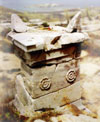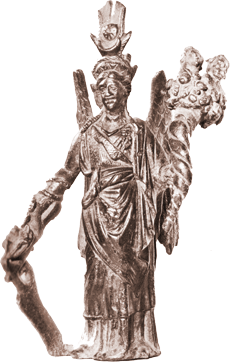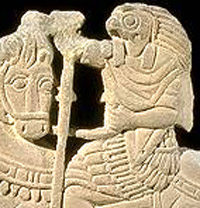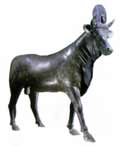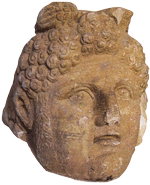Religious fusion in Ancient Egypt
At first glance, the Egyptian pantheon presents a bewildering array of gods having little in common with the Christian godman. But properly understood many Egyptian deities were city or regional “variations on a theme”, gods whose fortunes rose or fell with the outcome of human power struggles and dynastic change. Triumphant priests merged useful aspects of a fallen rival’s deity with their own favoured god.
This process of absorption, assimilation and adaptation continued throughout the Greek, Roman – and Christian eras. Though the basic Christ legend was formulated by apostate Jews, with their expectations of a conquering messiah, and pagan converts, with their fables of dying/reborn sun gods, Egypt provided Christianity with ideas NOT found in the Old Testament: immortality of the soul; judgment of the dead; reward and punishment; a triune god. The ancient religion of Egypt infused the nascent faith of Christ with much of its creed.
Conjuring up Christianity
Following the breakup of the empire of Alexander the Great, his general Ptolemy (323-282 BC) took possession of Egypt, Palestine and Cyprus. Alexandria, his capital, built on a spit of land unaffected by Nile floods between Lake Mareotis and the Mediterranean, traded the wealth of Egypt with the Greek world to the north and east. The great port became the hub of commerce between Europe, Asia, India and beyond. Settlers arrived from more ancient Greek cities, bringing Hellenic culture with them. Ptolemy himself encouraged artists and scholars from all nations to continue their work in his cosmopolitan city and, with royal patronage, Alexandria became the intellectual capital of the ancient world. A new syncretic culture emerged. Along with the trade goods into Alexandria flowed every philosophy and creed known in that part of the world. Into this most cosmopolitan of cities religions mingled and mixed and borrowed freely from the ancient faith of Egypt itself. Accessible even today, the catacombs of Alexandria graphically illustrate the cultural fusion of the Roman era – Greek sarcophagi, guarded by Egyptian gods, in Roman military uniform!
A Syncretic Tradition
The Greek general Ptolemy styled himself as an Egyptian pharaoh and took the title “Soter” (“Saviour”). As the astute ruler he understood the political value of an official religion. A single, composite deity, one god, one all-embracing system of belief, might unify the diverse, often antagonistic peoples of his polyglot empire and strengthen their devotion to the god’s earthly representative – himself.
Of all the Pharaonic–Greek gods Serapis survived the longest, well into the Roman period.
Serapis - a Greco-Egyptian "Zeus"
A composite god, Serapis took on aspects of Osiris, king of the Underworld, and Apis, the cow-god sacred to Memphis.
The basket (or ‘Bushel’) on the head of the god indicated a plentiful harvest.
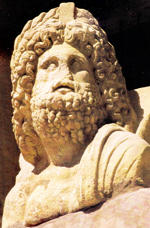

Honoured by Rome
“This fortunate usurper was introduced into the throne and bed of Osiris.” – Gibbon
“Vespasian … crossed over to Alexandria, so as to be able to control the keys to Egypt. There he dismissed all his entourage and entered the Temple of Serapis, alone, to consult the auspices and discover how long his reigh would last. There he was granted a vision … “
“As Vespasian sat on the Tribunal, two labourers, one blind, the other lame, approached together, begging to be healed. Apparently, the god Serapis had promised them in a dream that if Vespasian would consent to spit in the blind man’s eyes, and touch the lame man’s leg with his heel, both would be made well. Vespasian had so little faith in his curative powers that he showed great reluctance in doing as he was asked; but his friends persuaded him to try them – in the presence of a large audience, too – and the charm worked.”
Syncretism – The Greeks of Egypt Go Native
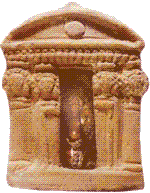
Death rites
Alexandria, 2nd century BC
Sarcophagus
A Greek sarcophagus -vines and satyrs of Dionysus (foreground) with Egyptian backdrop (Anubis, Horus and Thoth).
Catacomb of Kom el-Shoqafa, Alexandria
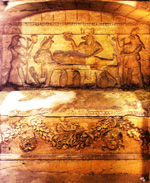
Out of Egypt
“In their hidden character the enigmas of the Egyptians were very similar to those of the Jews.”
– Clement of Alexandria, Stromata, v7 iii p56.
This process occurred most energetically in Egypt, a land awash with religious iconography. From the 3rd century AD onwards, Egyptian Christian – ‘Coptic’ – art displayed a syncretistic and fused tradition – Roman, Greek and Pharaonic – with a Christian veneer. Such art faithfully reflected a deeper truth: the regurgitation of ancient religious belief in the new guise of ‘Christianity.’
Trinity and Saviour God
“The works of art, the ideas, the expressions, and the heresies of the first four centuries of the Christian era cannot be well studied without a right comprehension of the nature and influence of the Horus myth.”
Isis was part of a sacred triad. The Egyptians deified so-called ’emanations’ of the supreme, unknowable godhead, typically grouping them into trinities (in fact, a whole hierarchy of trinities). Thus Isis-Osiris-Horus, Amun-Re-Mut-Khons, Atum-Shu-Tefnut-Mahet, etc., etc., reigned for forty centuries, an eternal, evolving godhead. Crucially, the Egyptian priests linked the gods directly to their ruling kings:
‘Throughout the 4000 years of Egyptian history every Pharaoh was the incarnation of the youthful Horus, and therefore the son of Isis, the Goddess Mother who had suckled and reared him. At death … as Osiris he held sway over ‘Those Yonder’ in the shadowy kingdom of the dead.’
Thus the ‘Father’ and ‘Son’ were inseparable, were of ‘one essence,’ the same stuff in continuous metamorphosis.The pharaohs stepped into the trinity on Earth (as Horus) and became the heavenly element (as Osiris) after death. In the endless cycle Isis functioned as sister, wife and mother, a sort of ‘holy spirit’, keeping the whole thing going.
Where Did They Get Their Ideas From?
Horus Rising

Horus, originally a sky god (hence the falcon’s head) became one of the most important of Egyptian gods. Over time Horus absorbed the characteristics of many other deities.

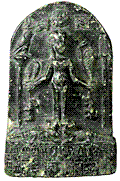
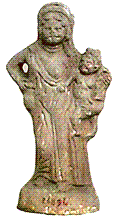
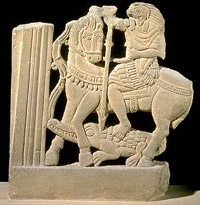
Egypt, 4th century AD
Horus crushes Seth – the murderer of his father, Osiris – represented as a crocodile
The image of Horus on horse-back was unknown in Egypt before the Greek era. But the myth was ancient: Good conquers Evil.
Egypt, 7th century tapestry
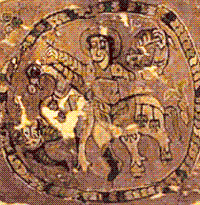
Egypt, 18th century
Regurgitated fables, reused symbols, recycled sacred space
“Without his mother Isis the child Horus could not have existed.
It is in the light of this fact of Egyptian mythology that we must regard emergent Christianity’s struggle, so bitterly fought at Alexandria, against what was then its most stubborn and insidious foe.”
Mother and Child – "Isis Myrionymos"
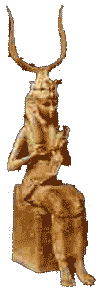

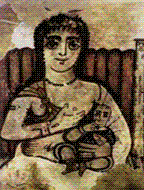
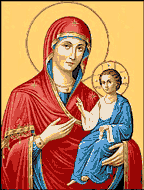
Roman Egypt: Ancient Melting Pot
“The Egyptians reasoned that if it was the fate of the god Osiris to be resurrected after death, then a way could be found to make it the fate of man, too… The bliss of immortality that had formerly been reserved only for kings was then promised to all men… “
– Lewis Brown (This Believing World, p84)
Among all these displaced and disorientated races moved the agents of diverse cults and ‘mystery religions’, competing for membership and stealing each others ideas. The most successful cult of all – the supreme example of syncretism – was Christianity.
Pax Romana
“The Word, then, visited that Earth in which He was yet always present…
Coming as God and as Man… Revealing Himself, conquering Death, and restored to life.”
– On the Incarnation.
Thus the religion of the Pharaohs was recast in Christian form – theology, iconology and the whole glorious paraphernalia of priestcraft.
The Romans create a God: Antinous
“For Antinous the full-scale apparatus of a cult was to be brought into being with temples and priests, images and altars, oracles and mysteries, games and a carefully developed myth. His was the only non-imperial head ever to appear on the coinage.”
– R. Lambert (Beloved and God, p147)
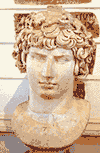
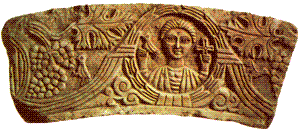
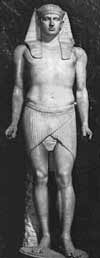
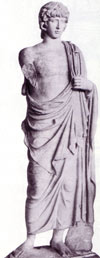

And the Christians Destroy A God ...
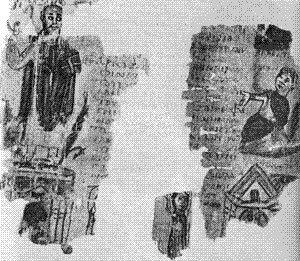
Sources
- William Dalrymple, From the Holy Mountain (Flamingo. 1998)
- Michael Walsh, A Dictionary of Devotions (Burns & Oates, 1993)
- Dom Robert Le Gall, Symbols of Catholicism (Editions Assouline, 1997)
- Leslie Houlden (Ed.), Judaism & Christianity (Routledge, 1988)
- Norman Cantor, The Sacred Chain – A History of the Jews (Harper Collins, 1994)
- R. E. Witt, Isis in the Ancient World (John Hopkins UP, 1971)
- Alison Roberts, Hathor Rising-The Serpent Power of Ancient Egypt (Northgate, 1995)
- Timothy Ware, The Orthodox Church (Penguin, 1993)
- Barbara Watterson, The Egyptians (Blackwell, 1997)
- P. H. Newby, Warrior Pharaohs (Faber & Faber, 1980)
Related Articles:
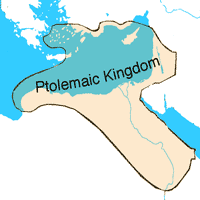
While Rome waged a struggle with Carthage, the Ptolemies were masters of the eastern Mediterranean.ary friend on the JNE YouTube channel

